Many know Botox for its ability to reduce the appearance of facial wrinkles. However, Botox is also frequently used to treat a variety of medical conditions such as repetitive neck spasms, excessive sweating, an overactive bladder, and lazy eye. Botox was FDA approved in 1991 for therapeutic use and later for cosmetic use. In 2010, the FDA approved Botox as a preventive treatment option for chronic migraines. Read further to understand more about the different types of pain relief one can obtain with Botox.
What Is Botox?
Botox is an injectable drug that is made with botulinum toxin type A made by bacterium Clostridium botulinum. This toxin can cause a life-threatening form of food poisoning, known as botulism, when ingested. However, if you were to inject it into your body, it has a different effect. Once injected, Botox will block certain chemical signals from your nerves which causes a temporary paralysis of treated muscle(s).
Botox Can Be Used To Treat Migraines
If you have been suffering from chronic headaches for a prolonged period, Botox is one of the possible treatments you can try. Your doctor may not recommend Botox injections until other treatment options are proven to be unsuccessful. However, if you do decide to undergo Botox treatments for migraines, your doctor will typically administer the injections once every three months. Each session can last between 10 to 15 minutes. Botox will be injected in multiple doses into specific points along the bridge of your nose, your temples, your forehead, the back of your head, your neck, and your upper back. Depending on how well you respond to Botox, your doctor will then recommend a length of time for your treatment plan.
It is important to note that usually Botox treatment will be suggested only if the adult patient has suffered from chronic migraines for more than 15 days per month, with the headache lasting 4 hours a day or longer. If the frequencies of your headaches do not match the above requirements, it is perhaps better for you to consider other alternatives as the safety and effectiveness have not been established for the prevention of episodic migraines that are 14 headache days or fewer per month.
Botox Treatment For TMJ Disorders
Botox may be used as an alternative treatment for TMJ (temporomandibular joint) disorders and associated jaw tension and pain. However, this treatment for TMJ disorders is specialized and it is important that you seek professional advice before undergoing such treatments.
During the treatment, Botox will be injected into muscular structures afflicted with soreness and discomfort, it can relieve TMJ disorders and jaw tension by decreasing spasms and improving overall muscle flexibility.
Botox Treatment For Spasmodic Torticollis/Cervical Dystonia
Spasmodic torticollis/cervical dystonia is a painful chronic neurological movement disorder that can cause involuntary neck movement. The cause of this disorder is predominantly unknown, and some people may develop the disorder because of another disorder or disease. Patients can experience varying degrees of pain in the cervical region and usually the pain intensity is directly related to the disease severity. Botox is currently considered the treatment-of-choice for Cervical Dystonia and is proven to lead to an improvement in pain and symptoms in up to 90% of the patients.



